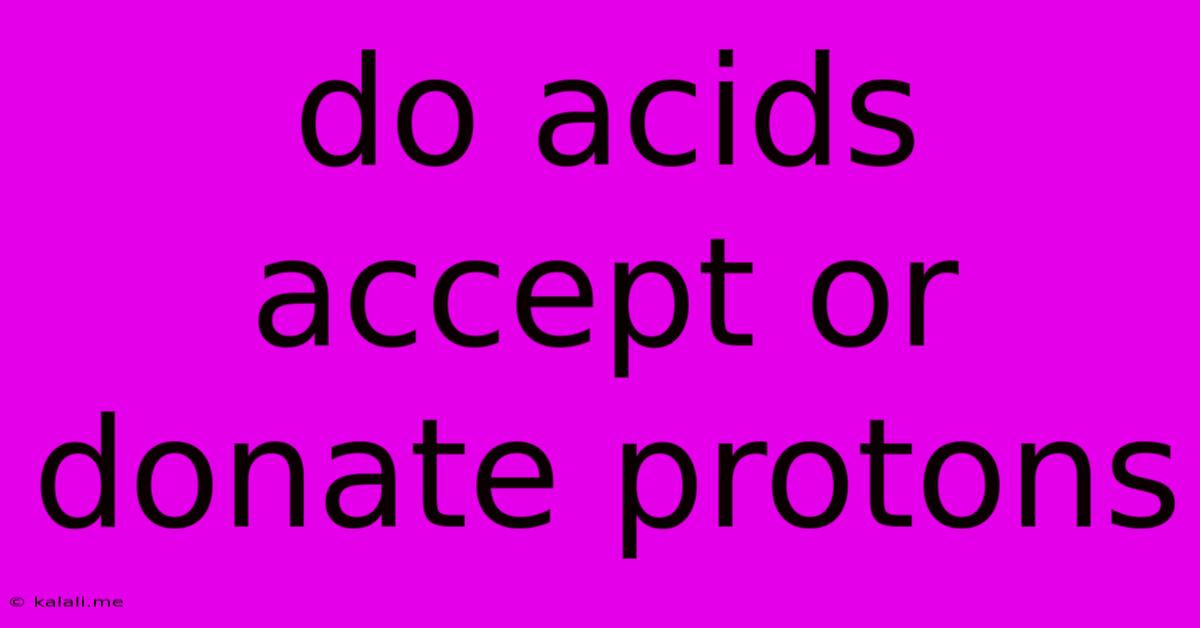Do Acids Accept Or Donate Protons
Kalali
May 10, 2025 · 3 min read

Table of Contents
Do Acids Accept or Donate Protons? Understanding Acid-Base Chemistry
Understanding whether acids accept or donate protons is fundamental to grasping acid-base chemistry. The short answer is: acids donate protons. This definition, while seemingly simple, underpins a vast array of chemical reactions and phenomena. This article will delve deeper into this concept, exploring the Brønsted-Lowry theory and providing examples to solidify your understanding.
What is a Proton?
Before we dive into acids, let's clarify what a proton is. In the context of chemistry, a proton refers to a hydrogen ion (H⁺), essentially a hydrogen atom that has lost its single electron. Protons are highly reactive due to their positive charge and are central to acid-base reactions.
The Brønsted-Lowry Theory: The Key to Understanding Proton Donation
The Brønsted-Lowry theory is the most common way to define acids and bases. According to this theory, an acid is a substance that donates a proton (H⁺), while a base is a substance that accepts a proton. This proton transfer is the defining characteristic of Brønsted-Lowry acid-base reactions.
Examples of Acids Donating Protons
Let's illustrate this with some common examples:
-
Hydrochloric acid (HCl): When HCl dissolves in water, it readily donates a proton to a water molecule, forming hydronium ions (H₃O⁺) and chloride ions (Cl⁻). The reaction can be represented as: HCl + H₂O → H₃O⁺ + Cl⁻. Here, HCl acts as the acid, donating a proton to the water molecule (which acts as a base).
-
Sulfuric acid (H₂SO₄): Sulfuric acid is a strong diprotic acid, meaning it can donate two protons. In its first dissociation, it donates one proton to water: H₂SO₄ + H₂O → H₃O⁺ + HSO₄⁻. The resulting bisulfate ion (HSO₄⁻) can then donate a second proton in a subsequent reaction.
-
Acetic acid (CH₃COOH): Acetic acid is a weak acid, meaning it only partially dissociates in water. It donates a proton less readily than strong acids like HCl or H₂SO₄. The equilibrium reaction is: CH₃COOH + H₂O ⇌ H₃O⁺ + CH₃COO⁻. Note the equilibrium arrows indicating that the reaction is reversible.
Understanding Conjugate Acid-Base Pairs
When an acid donates a proton, it forms its conjugate base. Similarly, when a base accepts a proton, it forms its conjugate acid. In the HCl example above, Cl⁻ is the conjugate base of HCl, and H₃O⁺ is the conjugate acid of H₂O. These conjugate pairs are crucial in understanding the equilibrium of acid-base reactions.
Beyond the Brønsted-Lowry Definition: Lewis Acids
While the Brønsted-Lowry theory focuses on proton transfer, the Lewis theory provides a broader definition of acids and bases. A Lewis acid is a substance that accepts an electron pair, while a Lewis base is a substance that donates an electron pair. While not directly related to proton donation, it's important to note this alternative perspective, as many substances that are not Brønsted-Lowry acids can still function as Lewis acids.
In Conclusion
In summary, acids, according to the Brønsted-Lowry theory, are defined by their ability to donate protons. This proton transfer is the cornerstone of many chemical reactions and is crucial for understanding acid-base behavior. While the Lewis definition expands the scope of acid-base chemistry, understanding proton donation remains central to comprehending the fundamental nature of acids.
Latest Posts
Latest Posts
-
How Did The Earth Get Populated According To The Bible
Jun 01, 2025
-
Minecraft World File On A Server
Jun 01, 2025
-
Disinclined To Acquiesce To Your Request
Jun 01, 2025
-
Fill Bike Tire At Gas Station
Jun 01, 2025
-
Apex By Defaylkt With Sharingf Or Witrhout Sharing
Jun 01, 2025
Related Post
Thank you for visiting our website which covers about Do Acids Accept Or Donate Protons . We hope the information provided has been useful to you. Feel free to contact us if you have any questions or need further assistance. See you next time and don't miss to bookmark.